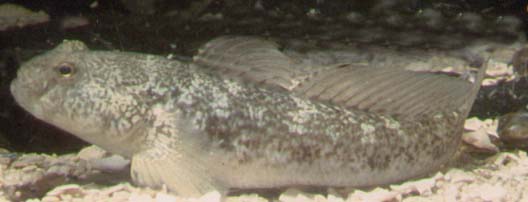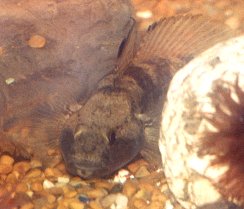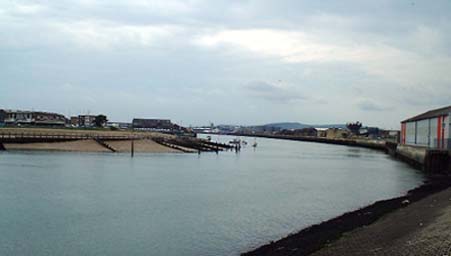| Identification:
Medium-sized goby (a family of small fishes with a notorious reputation
of being difficult to differentiate, characterised by a pair of dorsal
fins, and a pelvic fin fused into a weak suction cup). The first dorsal
fin is elongate, especially the third and fourth spines, in this
species (but not in Gobius paganellus) during the breeding season.
Cream, fawn or sandy with black blotches, sometimes it will appear black.
In breeding coloration the elongate first dorsal fin is distinctive.

|

|

|
|
Black Goby
|
Black Goby
|
Rock Goby
|
Photographs
by Richard Yorke
Presence of black sensory
papillae on the head of the Black Goby is an excellent ID character.
|
Note the absence of black
papillae on the Rock Goby. |
It appears that the elongated first dorsal fin spines are not always
present. This has suggested four possibilities, i.e. misidentification,
hybrids, a third species, or that the fish loses (or fails to develop)
the elongated spines. Further research in progress. Comments welcome.
Further research shows that young specimens lack the elongate dorsal
fin which in the specimen developed a small elongation at a size of 75
mm (August 2002) but it had lost the elongation by the length of 90 mm
(January 2003) (Specimen from Kingston beach,
2002).

The
fish is probably Gobius niger, but in this photograph the appearance
is very similar to the Rock Goby
A new species Gobius couchi has been described.
The big black smudges on the side of the body obscure the smaller spots
and are diagnostic (in British seas). The absence of large blotches can
indicate the similar Rock Goby. These smudges are obscured in breeding
coloration of both G. niger and G. paganellus and sometimes
at other times.
32-45 scales on the lateral line, less than the Rock Goby.
Link to the Porcupine Society 1998 Talk on this
subject.
Two
males and a female Gobius niger in a territorial display (click
on the text to find the photograph). Photographed at Tjärnö
Aquarium by Mike Noren. Quite proud of this one.
Similar Species: Rock Goby, Gobius
paganellus. Colour scheme (except when breeding),
size and habitats are the same as the Dragonet,
Callionymus
lyra.
Breeding:
Spring around the British coasts. The eggs are laid on the underside
of rocks and shells, usually in shallow water below low water mark, but
also in large estuaries where the salinity may be reduced. Male fish turns
a blacker tinge when guarding the nest. The third and/or fourth spine
of the first dorsal fin is longer than the others and this is never the
case with the similar Rock Goby.

Photograph
by © Luke
Richards from a specimen found under a rock in the River Medina (IOW)
The eggs are laid in a single layer (1.5 mm in height) and guarded
by the male. The eggs will hatch between 6 & 13 days (depending on
temperature). This is a considerably less time than G. paganellus.
Habitat:
In sandy and muddy areas, usually with rock as
well, below low water mark and sometimes found intertidally in large pools.
The adults are found at low water mark in late summer and autumn, and occasionally
under rocks in spring.
Found in low salinity areas, possibly brackish
(>3.0%), e.g. estuaries, Baltic.
Food:
Small crustaceans, worms, small fish.
Range:
Off all the coasts of Britain and further afield, Baltic, in the shallow
seas off the coast of southern Norway, France, Spain, Portugal, temperate
Africa, Mediterranean., Black Sea.

Locations:
Old Fort pools adjacent to the Training Wall, River Adur, at Shoreham
Beach, Sussex. (outer estuary)
Kingston Beach, Shoreham-by-Sea, Sussex.
(outer estuary)
Outer Estuary main stream, River Adur, Shoreham-by-Sea,
Sussex.
Horsea Island Divers Training Pool, Hampshire. (saline pool).
River Medina (Isle of Wight)
Additional Notes:
Common.
References:
Reproductive
Traits Of Gobius Niger (Teleostei: Pisces) Following A Salinity Stress:
Is It Really A Sedentary Lagoon Species?
C. Pampoulie, F. Priour, J.L. Bouchereau, E.
Rosecchi, A.J. Crivelli
Reports:
Horsea Island: There were dozens or hundreds
of them with:
1) a dark spot on the top of each dorsal
fin when raised, very clear in some, less so in others
2) dorsal fin with faint spotting in lines
along them like the Painted Goby, Pomatochistus pictus, but less
obvious
3) some of the largest with the anterior
dorsal fin clearly pointed
4) row of dark blotches along the flanks
was very typical of almost all individuals, but I would not regard this
as diagnostic
5) quite happy on mud which is unlikely
for the Rock Goby
6) tolerant of non-standard salinity.
Horsea report by Jane Lilley
July 2003
My 5 and 7 year old sons recently caught two
black gobies while fishing in Argyllshire. The fish were caught off a pier
in Tayvallich (OS reference 742871, Landranger
sheet 55).
They were both about 6 inches (15 cm) long
and each displayed extended dorsal spines - in fact there were distinctive
long (0.5-1.0 cm), flowing, trailing tips to the first 2/3 spines - possible
as a result of the extremely low current flow in the sheltered 'appendix'
to a sea loch in which they were living ? Dark blotches were present and
fused fins below. Underwater, when viewed from above they appeared black.
Information wanted: Please send any records of this fish, with location,
date, who discovered it, how it was identified, prevalence, common name
and any other details to Shorewatch
Project EMail  Glaucus@hotmail.com.
Glaucus@hotmail.com.
All messages will receive a reply.
Link: Gobies1.htm
Information supplied by Andy Horton (British
Marine Life Study Society)
Differences between Blennies &
Gobies
Gobies are difficult to
identify. Photographs in books cannot be relied upon because the identifications
of British species are wrong over 50% of the time.
|


 Glaucus@hotmail.com.
Glaucus@hotmail.com.